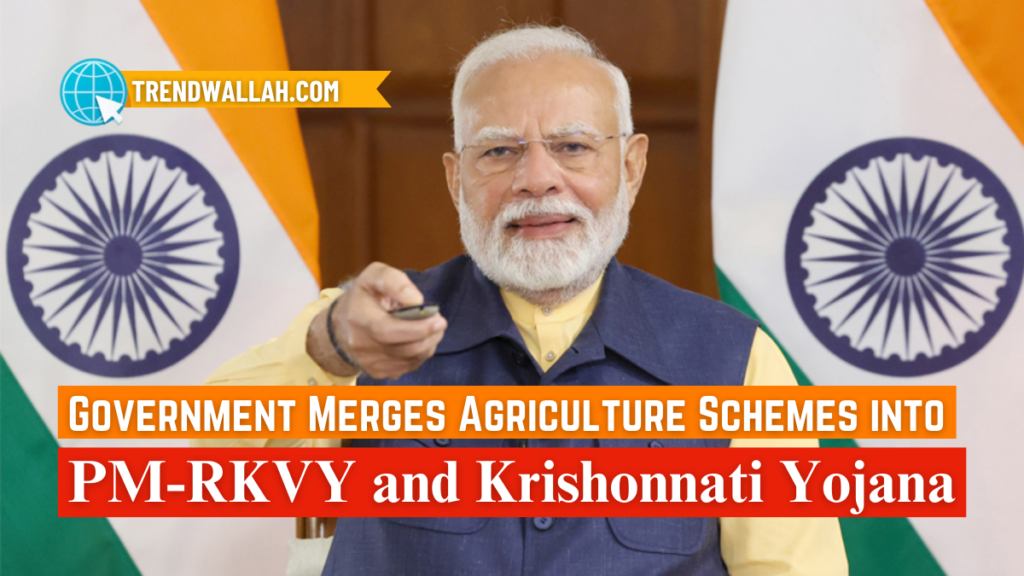
PM-RKVY and Krishonnati Yojana| In a major decision to streamline agricultural development, the Government of India has rationalized various central sector schemes under the Ministry of Agriculture and Farmers Welfare into two main schemes: Pradhan Mantri Rashtriya Krishi Vikas Yojana (PM-RKVY) and Krishonnati Yojana (KY). This move, approved by the Union Cabinet chaired by Prime Minister Narendra Modi on October 3, 2024, aims to enhance sustainable agriculture and food security across the country.
Objectives of PM-RKVY and Krishonnati Yojana
- Pradhan Mantri Rashtriya Krishi Vikas Yojana (PM-RKVY): Focuses on sustainable agriculture by integrating pre- and post-harvest infrastructure, promoting agri-entrepreneurship, and innovative value additions.
- Krishonnati Yojana (KY): Aims to improve food security and agricultural self-sufficiency, addressing all aspects of production, productivity, and better returns to farmers.
PM-RKVY and Krishonnati Yojana- Scheme Outlay
The total financial outlay for PM-RKVY and KY stands at ₹1,01,321.61 crore, with the central government contributing ₹69,088.98 crore, and state governments sharing ₹32,232.63 crore. Out of the total allocation:
- PM-RKVY receives ₹57,074.72 crore.
- Krishonnati Yojana receives ₹44,246.89 crore.
Key Features of PM-RKVY and KY
- Sustainable Growth: Both schemes will focus on enhancing crop diversification, soil health, and rainfed area development.
- Holistic Approach: Agricultural mechanization, agroforestry, and crop residue management are core components.
- Technology Integration: The schemes will leverage advanced technology to modernize agricultural practices, making them more efficient.
Reason for Scheme Rationalization
The decision to merge schemes was taken to:
- Reduce duplication and ensure convergence.
- Provide flexibility to states to create strategic plans based on regional needs.
- Focus on nutrition security, climate resilience, and value chain development.
History and Evolution
- The Rashtriya Krishi Vikas Yojana (RKVY) was originally launched in 2007-08 to promote inclusive agriculture.
- The Krishonnati Yojana (KY), launched in 2005, consolidated 12 schemes related to agriculture for holistic sector growth.
Funding Pattern
- Northeast States: 90% central government, 10% state government.
- Other States: 60% central government, 40% state government.
- Union Territories: 100% central government funding.
Project Approval Process
State governments will submit Annual Action Plans (AAPs) for approval through the State Level Project Screening Committees (SLPSC) and the State Level Sanctioning Committees (SLSC).
PM-RKVY and Krishonnati Yojana- News Summary:
- The Government of India has merged agricultural schemes into PM-RKVY and Krishonnati Yojana.
- The total outlay is ₹1,01,321.61 crore.
- These schemes aim to promote sustainable agriculture and ensure food security.
- The states will have flexibility in implementing the merged schemes.
Scheme Outlay Breakdown
| Scheme | Total Outlay (₹ crore) | Central Share (₹ crore) | State Share (₹ crore) |
| PM-RKVY | 57,074.72 | 38,497.58 | 18,577.14 |
| Krishonnati Yojana | 44,246.89 | 30,591.40 | 13,655.49 |
| Total | 1,01,321.61 | 69,088.98 | 32,232.63 |
Also Read Latest Current Affairs 2024
PM-RKVY focuses on promoting sustainable agricultural practices, soil health, rainfed area development, and agricultural mechanization.
The combined outlay for PM-RKVY and Krishonnati Yojana is ₹1,01,321.61 crore.
Krishonnati Yojana aims to achieve food security and agricultural self-sufficiency by enhancing productivity and ensuring better returns for farmers.
The scheme provides flexibility to state governments to design their agricultural strategies, reducing duplication and ensuring more focused development.
Funding varies: Northeast states receive 90% from the central government, while other states receive 60%. Union Territories are fully funded by the central government.
PM-RKVY evolved from the Rashtriya Krishi Vikas Yojana (RKVY) launched in 2007, and Krishonnati Yojana started in 2005 as an umbrella scheme.
Both schemes will use advanced technology to improve agricultural practices, focusing on efficiency and better outcomes for farmers.
